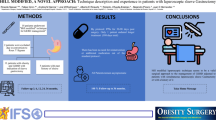Abstract
Purpose
The development of gastroesophageal reflux disease (GERD) is a commonly encountered scenario after sleeve gastrectomy. A recently reported technical amendment to incorporate a Nissen fundoplication is discussed in this multimedia article focussing on optimising outcomes and reducing complications.
Materials and Methods
An intraoperative video has been edited to demonstrate the Nissen-Sleeve Gastrectomy and important technical considerations in its technical performance.
Results
Gastrolysis is performed proximally from 6 cm proximal to the pylorus. Routine full mediastinal mobilisation of the oesophagus (5 cm) is completed. Cruroplasty is routinely performed. A short Nissen fundoplication is completed calibrated on a 37 French bougie and then sleeve gastrectomy is performed. Our team’s experience suggests that careful manipulation of the fundus and using reproducible measurements of the fundus are key to completing the fundoplication whilst minimising complications. A control test with mobilisation of the bougie through the wrap is recommended at the end of the procedure.
Conclusion
The Nissen-Sleeve Gastrectomy, as presented in this video, is safe and has good short-term efficacy outcomes. Longer term and randomised studies are ongoing.
Similar content being viewed by others
References
Welbourn R, Hollyman M, Kinsman R, et al. Bariatric-metabolic surgery utilisation in patients with and without diabetes: data from the IFSO Global Registry 2015-2018. Obesity Surgery. 2021;31(6):2391–400.
Yeung KTD, Penney N, Ashrafian L, et al. Does sleeve gastrectomy expose the distal esophagus to severe reflux?: a systematic review and meta-analysis. Ann Surg. 2020;271(2):257–65.
Vanetta C, Dreifuss NH, Schlottmann F, et al. Bariatric surgery conversions in MBSAQIP centers: current indications and outcomes. Obes Surg. 2022;32(10):3248–56.
Nocca D, Nedelcu M, Loureiro M, et al. The Nissen sleeve gastrectomy: technical considerations. J Laparoendosc Adv Surg Tech A. 2020;30(11):1231–6.
Nocca D, Skalli EM, Boulay E, et al. Nissen sleeve (N-Sleeve) operation: preliminary results of a pilot study. Surg Obes Relat Dis. 2016;12(10):1832–7.
Nocca D, Galtier F, Taleb S, et al. Peri-operative morbidity of Nissen sleeve gastrectomy: prospective evaluation of a cohort of 365 patients, beyond the learning curve. Obes Surg. 2022;32(7):1–7.
t Hart JWH, Noordman BJ, Biter LU, et al. Nissen-Sleeve procedure versus laparoscopic Roux-en-Y gastric bypass in patients with morbid obesity and gastro-oesophageal reflux disease: protocol for a non-inferiority randomised trial (GINSBY). BMJ Open. 2022;12(6):e061499.
Olmi S, Cesana G, Gambioli A, et al. (2022) Effect of laparoscopic sleeve gastrectomy vs laparoscopic sleeve + Rossetti fundoplication on weight loss and de novo GERD in patients affected by morbid obesity: a randomized clinical study. Obes Surg. 2022;32(5):1451–8.
Author information
Authors and Affiliations
Contributions
DN, ACC, SJ, PB, MN and TG were involved in research design. DN, ACC, SJ and PB were involved in data acquisition. DN, ACC, SJ, PB, MN and TG were involved in data interpretation, production of the manuscript and critical revisions. All authors approved the final submitted manuscript.
Corresponding author
Ethics declarations
Ethics Approval
The patient has consented to the use of this anonymised video.
Conflict of Interest
The authors declare no competing interests.
Additional information
Publisher's Note
Springer Nature remains neutral with regard to jurisdictional claims in published maps and institutional affiliations.
Key points
Nissen-Sleeve Gastrectomy is a safe and viable option for management of patients with severe obesity and gastroesophageal reflux disease.
Key factors to reduce complications when learning this technique include safe manipulation of the fundus and reproducible measurement of the fundus when creating the fundoplication.
Use of an orogastric bougie is recommended to standardise the cruroplasty closure and fundoplication wrap and to reduce the risk of postoperative dysphagia.
Supplementary Information
Below is the link to the electronic supplementary material.
(MP4 425 MB)
Rights and permissions
Springer Nature or its licensor (e.g. a society or other partner) holds exclusive rights to this article under a publishing agreement with the author(s) or other rightsholder(s); author self-archiving of the accepted manuscript version of this article is solely governed by the terms of such publishing agreement and applicable law.
About this article
Cite this article
Nocca, D., Currie, A.C., Joumaa, S. et al. A Video-Based Review of Important Technical Concepts in the Nissen-Sleeve Gastrectomy. OBES SURG 33, 1304–1306 (2023). https://doi.org/10.1007/s11695-022-06429-7
Received:
Revised:
Accepted:
Published:
Issue Date:
DOI: https://doi.org/10.1007/s11695-022-06429-7




